
I spent the past weekend surrounded by Sikh Art and Film at the annual Spinning Wheel Film Festival in Hollywood. I usually attend these events with high expectations, hoping to be inspired and moved and there are always one or two films that provide that sustenance. The films were creative, such as The Making of Liverpool – an artistic animation inspired by a painting by The Singh Twins which explores 800 years of Liverpool’s history. The films were educational, such as Cultural Safari – directed by Sandeep Singh and produced by the Kaur Foundation – describing the basics of Sikhi for children of all ages [I have to say that this is one of the most impressive educational films I have come across]. The films were also daunting, such as Warrior Boyz – made by Baljit Sangra which touched upon the root causes of gang violence in the Punjabi community of Vancouver. A favorite of the crowd was Kuldip Powar’s Unravelling – a poetic inter-generational dialogue between the film director and his grandfather about the experience of war all posed in Urdu poetry.
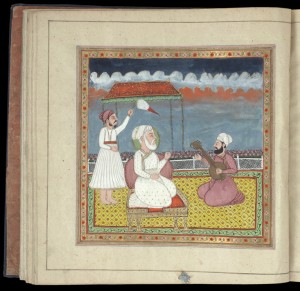 There were many other well-made films such as 35, Kabaddi Cops, and Right to Turban which rightfully deserve mention (and have been discussed or will be discussed in future posts), however what I appreciated most about the weekend was the final day of the festival – which was devoted to lectures on Sikh Art and History. Staff from the Anglo Sikh Heritage Trail and other UK-based organizations presented the attendees with a glimpse into the historical legacy of the Sikhs. One of the lectures was titled the Epic of Saragarhi and discussed the 21 soldiers of the Sikh regiment who defended a remote post against an estimated 10,000 hostile tribesmen. Michael O’Keefe from the British Library discussed Sikh artifacts and paintings and detailed an image of Maharani Jindan Kaur’s Gutka of the Sukhmani Sahib (see picture to the left). The day ended with a panel showcasing Sikhs in Theatre and Music, including traditional music and also hip-hop. Mandeep Sethi and Jagmeet Singh, rappers from LA, ended the festival with amazing performances showcasing their incredible talent of telling stories through hip-hop.
There were many other well-made films such as 35, Kabaddi Cops, and Right to Turban which rightfully deserve mention (and have been discussed or will be discussed in future posts), however what I appreciated most about the weekend was the final day of the festival – which was devoted to lectures on Sikh Art and History. Staff from the Anglo Sikh Heritage Trail and other UK-based organizations presented the attendees with a glimpse into the historical legacy of the Sikhs. One of the lectures was titled the Epic of Saragarhi and discussed the 21 soldiers of the Sikh regiment who defended a remote post against an estimated 10,000 hostile tribesmen. Michael O’Keefe from the British Library discussed Sikh artifacts and paintings and detailed an image of Maharani Jindan Kaur’s Gutka of the Sukhmani Sahib (see picture to the left). The day ended with a panel showcasing Sikhs in Theatre and Music, including traditional music and also hip-hop. Mandeep Sethi and Jagmeet Singh, rappers from LA, ended the festival with amazing performances showcasing their incredible talent of telling stories through hip-hop.
While the film festival brought together a plethora of Sikh art mediums – what it did seem to be missing was the representation of women and the voice of women in these films. The films were predominately made by men and the issues discussed were predominately issues affecting men. This brought several issues to mind – do young Sikh women not feel encouraged to enter the field of Film? Do the current male Sikh filmmakers not feel comfortable telling the story of Sikh women? It seems to be of vital importance that as we develop and promote Sikh films, we ensure that the stories we tell are representative of the entire Sikh panth and pay particular attention to the stories of Sikh women.
I will leave with this quote, mentioned by Harbinder Singh of the Anglo Sikh Heritage Trail, but also very pertinent to the theme of this weekend’s film festival.
Until lions tell their own history,
History will always glorify the hunters.
– African Proverb
Sundari’s recent post, addressing the portayal of Sikhs in an ad for the upcoming Spinning Wheel festival, brings up an interesting tension for Sikh women- the conflict between modern ideals of beauty, and the requirements of the Sikh faith.
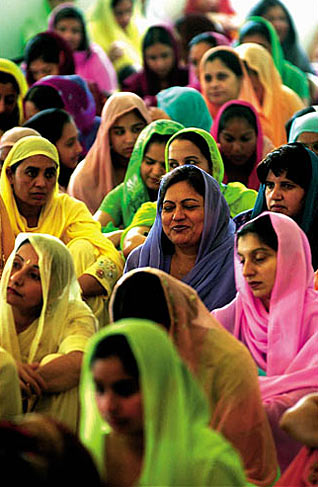 Generally (and unfortunately) women tend to value themselves (whether consciously or unconsciously) according to social valuations placed upon women… which revolve mostly around ideas of outer beauty- trends which vary a bit across region and time, but are all generally superficial. Women who have completely overcome this unconscious embrace of ideals of beauty are extremely rare. For those who think is untrue- think about how many times you’ve heard a female friend talk about the bad day she was having- many of the complaints probably had something to do with the way she felt she looked that day (that might not be the best example, but it’s the first that comes to mind). How we feel is too closely related to how we feel we look.
Generally (and unfortunately) women tend to value themselves (whether consciously or unconsciously) according to social valuations placed upon women… which revolve mostly around ideas of outer beauty- trends which vary a bit across region and time, but are all generally superficial. Women who have completely overcome this unconscious embrace of ideals of beauty are extremely rare. For those who think is untrue- think about how many times you’ve heard a female friend talk about the bad day she was having- many of the complaints probably had something to do with the way she felt she looked that day (that might not be the best example, but it’s the first that comes to mind). How we feel is too closely related to how we feel we look.
These social valuations of beauty are especially problematic for Sikh women in particular because these values are totally opposed to an important part of Sikh identity- our kesh. They are also problematic for all women because we’re not valuing what really matters- our thoughts, ideas and actions which really create who we are- but a superficial farce. Finally, these valuations are problematic because many modern ideals of beauty are unhealthy (but enough has been said about these last two points in general gender conversations that I don’t want to dwell on them).
The challenges and overt racism that Sikh men face in the US today because of their kesh are undeniable. But the solutions that address men’s kesh (mostly political responses, creating social awareness) don’t carry over as solutions for women.
Last week Bill Maher was a guest on the Daily Show, promoting his new movie Religulous and offering a clip. The clip happened to show a sardar in a London park, which was the extent of any Sikh’s appearance in the movie.
The name, ‘Religulous,’ is a portmanteau blending the words 1) religion and 2) ridiculous, and examines the overlap of those concepts. The movie’s proclaimed purpose is to promote doubt in the minds of those who have blocked doubt in religious teachings completely and subsequently hold totally irrational beliefs (i.e. reject evolution), though those who actually go to watch the movie probably wouldn’t be completely opposed to such doubt to be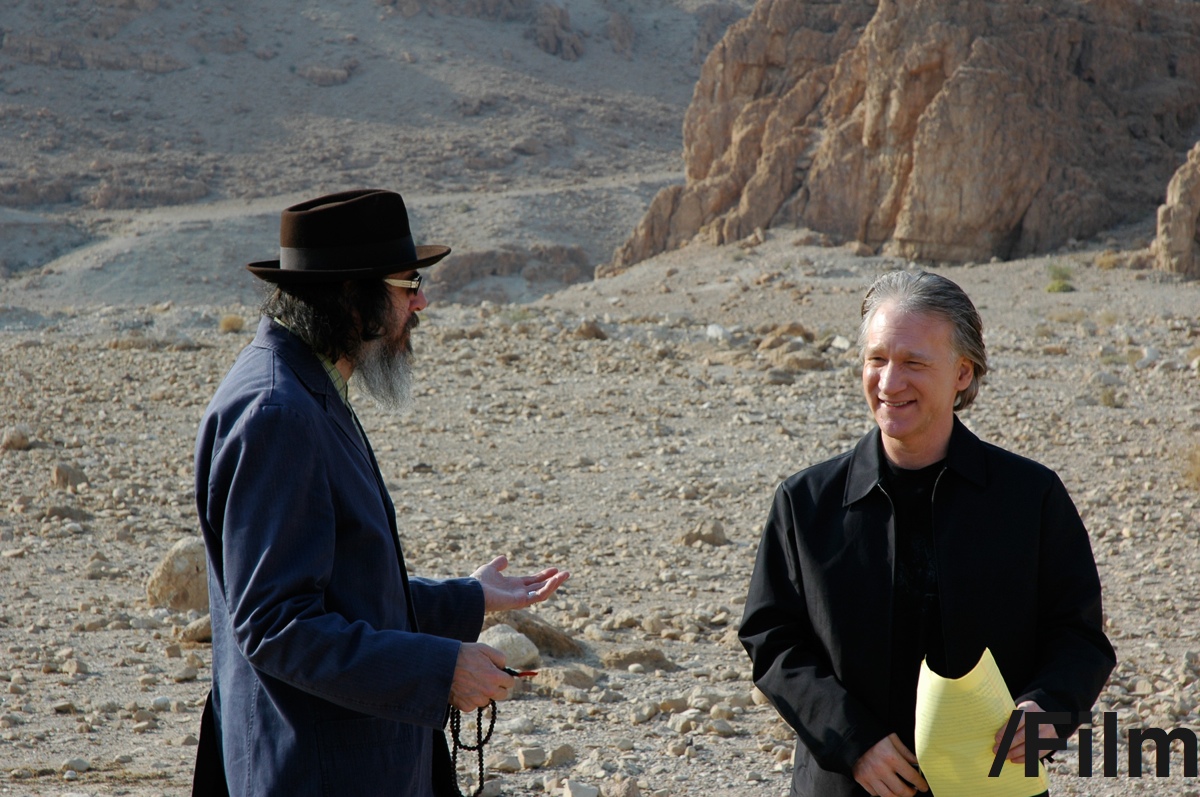 gin with. Of course at some point the explanations of rationality end, and there is the unknown. The point of the movie is to admit that it actually is unknown, and show that those who claim to know, really don’t.
gin with. Of course at some point the explanations of rationality end, and there is the unknown. The point of the movie is to admit that it actually is unknown, and show that those who claim to know, really don’t.
In the movie, Bill Maher interviews people from a variety of backgrounds and religious faiths (from a former head of the Human Genome Project and the former Director of the Vatican observatory to a British rapper). Some hold more nuanced views than others. He listens and asks questions of people who staunchly believe in literal translations of age old texts even when their beliefs scientifically absurd, and has some interesting (and comical) conversations. My favorite interview by far was with a very rational Vatican priest who happily admitted that Jesus’ birthday is not on December 25th and the Catholic church has absolutely no idea when it really is.
 Were you watching the Presidential debate last Friday? Did you catch flashes of a sardar in a blue turban? I assume that anyone who did was equally as surprised as I was (though happily so). Well, who is the mystery man? He’s Arvinder Singh Kang, a twenty five year old who was the only Punjabi, and the only Sikh at the University of Mississipi when he came from Punjab to do a graduate degree.
Were you watching the Presidential debate last Friday? Did you catch flashes of a sardar in a blue turban? I assume that anyone who did was equally as surprised as I was (though happily so). Well, who is the mystery man? He’s Arvinder Singh Kang, a twenty five year old who was the only Punjabi, and the only Sikh at the University of Mississipi when he came from Punjab to do a graduate degree.
I came to the U.S. in the fall of 2005, as a graduate student at the University of Mississippi. From a proud Sikh family, I was the first kid from my village and from my maternal and paternal lineage to come to America for studies.
I brought twenty-something Puggs (turbans). I knew Japji Sahib by heart and had been exposed to Sikh history more than I had been to comics. All through my undergrad years, I had taught my juniors how to wear a turban. There was no doubt, whatever the circumstances might be, I would always be a Turbanator!
While boarding a plane from London’s Gatwick Airport, I sat beside a Sikh girl living in Houston who was born and raised in London. “…So it’s going to be hard to keep a turban in university”, she said in a lovely British accent.
“Much nee te kuch nee!” (What’s a man without a mustache) I had quipped. [link]
You can read more from Arvinder at Sikhchic.
 Is the BBC biased towards creating religious programs focused predominantly on Islam versus other faiths? Apparently so, according to Hindu and Sikh leaders in the UK who claim that a disproportionate number of programs have been made about Islam, at the expense of programs on their own faiths. The Network of Sikh Organizations (NSO) media monitoring group analyzed programs from the BBC’s Religion and Ethics department and claim that since 2001, the BBC has made 41 programs on Islam, five on Hinduism and one on Sikhism.
Is the BBC biased towards creating religious programs focused predominantly on Islam versus other faiths? Apparently so, according to Hindu and Sikh leaders in the UK who claim that a disproportionate number of programs have been made about Islam, at the expense of programs on their own faiths. The Network of Sikh Organizations (NSO) media monitoring group analyzed programs from the BBC’s Religion and Ethics department and claim that since 2001, the BBC has made 41 programs on Islam, five on Hinduism and one on Sikhism.
Indarjit Singh, editor of the Sikh Messenger and a regular contributor to Thought for the Day on Radio 4’s Today programme, said Sikhs felt “brushed aside”. He said: “I think it’s probably unthinking, or inadvertent, but the bias is there. “I do know that within the Sikh community especially there is a feeling of concern over the lack of portrayal of their religion on television.” He added: “Of course it is important to educate non-Muslims about Islam, but it is also important to provide informative, open and respectful programming on all religions.” [link]
The people responsible for commissioning religious programming – whether on radio or television – acknowledge that world events have made a significant impact on their output – be it the death of John Paul II or the terrorist attacks of September 11 and July 7.
“Towelhead” is the title of a forthcoming Warner Brothers movie. The Sikh-American Legal Defense and Education Fund (SALDEF) is not pleased. Today, SALDEF issued a press release in which it states:
“The word ‘towelhead’ is a crude and racist slur that is commonly hurled at Sikhs and has frequently been documented in connection with hate crimes,” said Kavneet Singh, SALDEF’s Managing Director. “Calling a movie ‘Towelhead’ is like calling a movie ‘Nigger’ or ‘Gook,’ and we are shocked that a company like Warner Brothers would even consider using a racial slur as a movie title.”
Young Sikhs are extremely internet savvy. From the proliferation of videos on youtube to remixed dhadhi-jatha to an embrace of web 2.0, many young Sikhs are at the forefront of creating new avenues for education about their faith. While I personally believe that most Sikhs focus their attention on education for non-Sikhs, in my opinion, far more crucial is the intra-Sikh education.
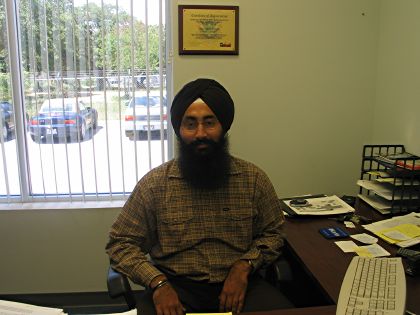 While in an earlier discussion I talked about the importance of the KhalsaKids website, launched last year by the Sikh Coalition. It is an example of Sikhs experimenting with new media forms to better address the needs and concerns of their community.
While in an earlier discussion I talked about the importance of the KhalsaKids website, launched last year by the Sikh Coalition. It is an example of Sikhs experimenting with new media forms to better address the needs and concerns of their community.
In a similar vein, the Sikh Research Institute has recently announced its plans for a “webinar” series, titled “Liv.”
Explaining the impulse of this new project, SikhRI head, Harinder Singh, states:
“We are regularly in touch with Sikh communities in North America, Europe and Asia who want us to deliver programs in their local communities on a regular basis, but it’s been quite difficult due to logistical and financial constraints. Now that we are introducing webinar facilities, our programs can reach anyone around the globe and we look forward to being able to engage with the vast Sikh communities outside of our traditional target area in North America”[link]
The “Liv” project entails four 90 minute seminars to begin at 8am PST (California time) on 4 consecutive Saturdays, beginning September 13, 2008. The first four topics listed on their website includes: “Sikhi – A Gurmat Framework,” “Bani – The Idea,” “Tavarikh (History) – The Revolution,” and “Rahit – The Lifestyle.”
A pre-registration is required to participate in the “webinar” and can be completed here.
While waking up at 8am on Saturdays is beyond my abilities, the seminars being conducted by The Harinder Singh sound intriguing and informative. I hope some of our readers can that do participate can discuss some of their thoughts on the format and the content here.
Also what are new ways that you have seen Sikhs embracing Web 2.0? (yes I am already aware of that one blog, uhhh but I can’t think of the name.)
Is the tipping point (the level at which the momentum for change becomes unstoppable) approaching for a change in attitudes towards the value of women and need to have sons?
There has been a widespread, public movement condemning sex-selection by the government, ngos, and others in the community for some time now (this hard-hitting song by Sarabjit Cheema is a must-see). Since Amartya Sen’s articulation of ‘missing women,’ the rights of women in developing countries have been at the forefront of international agendas. In a recent development, Sunita Rao, an Indian pop singer, has released a song condemning sex-selective abortion and become the spokesperson for the LAADLI campaign, funded by the United Nations Population Fund.
Suneeta Rao’s latest album WAQT’s press conference was held in Hotel Palace Heights, New Delhi. It was on behalf of United Nations Population Fund (UNFPA). The singer is the official spokesperson of the Laadli campaign of UNFPA that focuses on the pleasure and pride of having a daughter and motivates people to fight injustice against the girl child. ‘The video of the first song in my album ‘Sun Zara’ is a dedication to all girls, Suneeta said, UNFPA has gratefully supported in making the video of this album. According to United Nations Population Fund, “This video has been made for the Girl Child, to address the issue of Sex Selection and to help stop female feticide”. [link]
The song mentioned above, Sun Zara:
 For a place that makes money off turban-wearing and multicultural disney characters, it seems a little ironic that a turban-wearing employee of Walt Disney would be fired for not having the “Disney look.” Uhh what?
For a place that makes money off turban-wearing and multicultural disney characters, it seems a little ironic that a turban-wearing employee of Walt Disney would be fired for not having the “Disney look.” Uhh what?
This story has been getting a lot of press lately (so for the two of you who haven’t heard) Sukhbir Channa applied for a job (as a trumpet player) with Disney in September 2006 but was told that he couldn’t be hired unless he removed his religiously-mandated turban. He was told that he did not conform with Disney’s grooming and dress requirements known as the “Disney Look.” (Okay, but Aladdin does?) Our friend over at SikhSwim makes a good point,
On my last visit to Disney World, little kids, when they saw me, would say, “Hey look, it’s Aladdin!” So I think Disney’s position has no basis. I think Sikhs have the “Disney look” if average people confuse us for some of the popular Disney characters! [link]
SALDEF has stepped in to help Channa with his lawsuit,
“Disney’s position is fundamentally un-American because it forces Sikhs and also observant Jews and Muslims to sacrifice religious freedom in order to pursue their career goals,” said SALDEF Chairman Manjit Singh. “It is also hypocritical for Disney to make millions of dollars promoting cartoon characters that wear turbans and simultaneously reject the right of an employee to wear a turban in accordance with his faith.” [link]
Having earned a bachelor’s degree in music, Channa just completed a nine-month U.S. tour with the Broadway show Annie. We’ll update you as soon as we hear more about this story. In the meantime, what are your thoughts on this and am I the only one impressed that we know a Sikh trumpeter?!
 About a week ago, Sex And The City (SATC) hit theaters. Many may resist an association with the dating scene that the movie and show explored with the lives of Punjabi Sikh women, and wonder whether this is appropriate for The Langar Hall. But the stories and characters of SATC reflect broad ideas that apply to all women and since every woman I know has seen or is planning to see the movie, I’m curious about how these themes apply to Punjabi Sikh women in particular and how our experiences compare with other groups. This post does not promote anything portrayed in SATC, but instead explores the stereotypes in the characters and questions how our Punjabi-Sikh-ness affects how much of those stereotypes we embrace. First, what is SATC really about?
About a week ago, Sex And The City (SATC) hit theaters. Many may resist an association with the dating scene that the movie and show explored with the lives of Punjabi Sikh women, and wonder whether this is appropriate for The Langar Hall. But the stories and characters of SATC reflect broad ideas that apply to all women and since every woman I know has seen or is planning to see the movie, I’m curious about how these themes apply to Punjabi Sikh women in particular and how our experiences compare with other groups. This post does not promote anything portrayed in SATC, but instead explores the stereotypes in the characters and questions how our Punjabi-Sikh-ness affects how much of those stereotypes we embrace. First, what is SATC really about?
the three-girls-in-the-city movie… a cinematic staple since the 1920s, has been an unusually enduring and lucrative one, exploiting each succeeding era’s anxieties surrounding women’s changing roles and helping define those eras’ new ideas of modern life. In them, audiences can watch women negotiate and sometimes subvert the forces that limn and limit their choices. [link]
Skimming the other Sikh blogs, I found this post (on a great blog that I am starting to like and not just because he is also an Immortal Technique fan) about a Sikh conscious rapper from Toronto. Although I couldn’t find too much on the internet about Kanwer Singh, other than the fact he is a recent college graduate, the comments on his works have received much praise on youtube. Kanwar goes by Humble the Poet (maybe an allusion to Bhat Bani? SGGS 1400). I personally found this track amazing. (Don’t worry Joolz/Bobby/Suzy, no bad language here)
The track deals with a number of incidents that have plagued the Punjabi Sikh community in Toronto, Canada (although unfortunately Kitimat is there too). However these problems are hardly limited to Canada. They are the stories of our diaspora. From male youth violence, AIDS, domestic violence, alcohol abuse, and drug abuse, this song hits on it all. In fact many of these are themes that get talked about at the Sikh conference I mentioned yesterday. In case you were interested, you can download Kanwer’s track here.
Looks like I have another favorite Sikh rapper along with Mandeep Sethi from the Bay. Your thoughts?

We know the Britney Spears and Miley Rays of Hollywood tremendously influence the lives of our pre-teen and adolescent girls. The voices we keep hearing on television are those of white, multi-generational American, and suburban teens.

Their experiences are being boxed and represented as THE experience of adolescent girls in America. Rarely on television does the media interview pre-teen and teen girls of color from immigrant backgrounds living in urban/rural areas about their perceptions of life and the future – unless the story is on teen pathology from pregnancy to drugs and violence.
Therefore, I was pleased to see the trailer of a documentary, “Going on 13”, that is about pre-teen girls from minority, immigrant, and urban backgrounds discussing how they negotiate the whirlwind of changes and choices, from body image to relationships, just as girls in the suburbs.

The only distinction is how their social, economic, and cultural contexts add a different layer to the experience that is not a form of “mal-adaptation”, but another way of living. The film-makers’ goal was “… to show the reality of preteen girls and urban minorities, which isn’t often portrayed in the mainstream media” and “… wasn’t just focused on the pathology of urban youth”.
Guest blogged by Mewa Singh
This evening I had the opportunity to view a screening of a new documentary on the tragedy and heroism of the Sodhi Family. From the website of “A Dream in Doubt” comes the synopsis:
“A Dream in Doubt” is an immigrant story in a world in which patriotism has morphed into murder. When Rana Singh Sodhi’s brother is killed in America’s first post-9/11 revenge murder, he begins a journey to reclaim his American dream and fight the hate that continues to threaten his community. This intimate, hour-long documentary of one man’s odyssey from persecution in India to embracing America as his homeland proves that courage and hope have the power to overcome hate.
I was a little hesitant to post about this, especially considering the numerous discussions we’ve had on this blog related to the negative image of Sikhs in the media. While a big fan of independent documentaries, I admittedly sighed when I came across an article about Air India 182, a film which was the opening feature at HotDocs, a film festival that was held in Toronto last weekend. My initial thought was that this was yet another way of perpetuating negative race relations in Canada.
While a big fan of independent documentaries, I admittedly sighed when I came across an article about Air India 182, a film which was the opening feature at HotDocs, a film festival that was held in Toronto last weekend. My initial thought was that this was yet another way of perpetuating negative race relations in Canada.
Air India 182, as it is simply titled, is a first-person account of the events leading up to the Air India tragedy and weaves together stories from those who are “directly involved,” including the families of those who died, investigators, and the “conspirators themselves.” Considering this, I didn’t expect to come across the director’s apt observations of how these events unfolded for the Punjabi community and what that meant for Sikhs in Canada,
Ultimately, Gunnarsson wanted to personalize the tragedy, to show the people involved, and give much more of a voice to the victims’ families, whom he believes didn’t get enough political recognition. “I felt at the time that people in Vancouver in the Punjabi community were being deprived of their rights as citizens of Canada. They did not have the same relationship to law enforcement or to political leadership as I did. It was being brokered through so-called community leaders, and the brokerage tended to happen at temples,” he says. [Link]
Although my earlier discussion on multiculturalism put forth some of my thoughts, an interesting news item caught my interest yesterday. I guess this can be seen in a way as a part II of that original post.
While many of us spent our weekends remembering the spirit of the Khalsa, attending Nagar Kirtans, making rounds at the Vaisakhi Melas, or buying tickets for the upcoming Gurdas Mann tour, some New York Sikhs did something very different.
Sponsored by the Sikh Coalition, Sikhs in New York gathered at the steps of City Hall in protest. They released a report, “Making Our Voices Heard: A Civil Rights Agenda for New York City’s Sikhs.”
The report provides its own background:
In December 2006, the Sikh Coalition, with the help of several dedicated volunteers, began conducting the first ever civil rights survey of New York City’s Sikhs. The survey intended to gather information on Sikhs’ experiences with incidents of bias, employment discrimination, language access and other issues that hinder full integration into New York’s civic and political life.
This report represents the results obtained from the data we collected from 1,021 Sikhs who live in New York City’s five boroughs. The data presented in this report identifies significant gaps between the promise of the law and the Sikh community’s reality on the ground.
While Fortune Magazine used this picture in a recent advertisement for Dow Chemical Company, I first saw this image on the premiere issue of a new magazine I subscribe to. 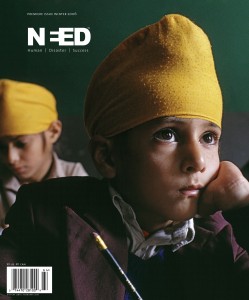 The image, by world-renowned photographer Steve McCurry, was chosen for the cover of the first issue of NEED magazine, an independent publication dedicated solely to global and domestic humanitarian issues.
The image, by world-renowned photographer Steve McCurry, was chosen for the cover of the first issue of NEED magazine, an independent publication dedicated solely to global and domestic humanitarian issues.
Steve McCurry is founder of ImagineAsia – an organization that helps children in rural Asian communities by addressing fundamental education and healthcare needs. The image, displaying Sikh children, was used to display (among other images) the pictorial state of education in Afghanistan. The education system in Afghanistan was virtually destroyed following successive wars and oppression by the Soviet Union and the Taliban. McCurry has been covering Afghanistan since before the Russian invasion in 1979. He has a unique and intimate knowledge of the country. He saw first-hand the turmoil of war and an entire generation of Afghans lose an opportunity to be educated. The result is a shattered country that ranks among the most illiterate in the world. [NEED Magazine]
Afghanistan’s children represent the country’s hopes for a better future, and education is the key to that future. The country’s new constitution makes education mandatory for children up to grade nine. This is a unique window of opportunity in Afghanistan’s history, a time when the need for education has been recognized and children are yearning to go to school. – Steve McCurry, Winter 2006 issue, NEED magazine.
You can order this issue (Winter 2006) of NEED magazine by viewing this website.

